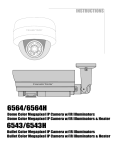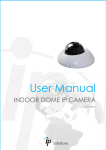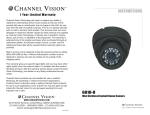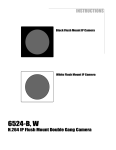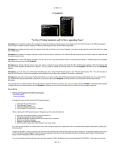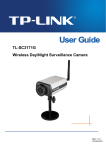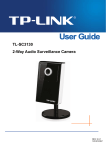Download - Channel Vision Technology
Transcript
6532 1.3 Megapixel Mini Dome IP Camera w/POE 13 Table Of Contents 2 Model 6532 The 6532 is a 1.3 Megapixel Mini Dome IP Camera w/POE • Built-in web server allows a user to view high quality, real-time video with Internet Explorer browser. • Multi-Stream H.264, MJPEG and MPEG • Live video can be recorded to an NVR and played back remotely, as well as viewed from many mobile phones and other devices. • Designed for large commercial projects with 100’s of cameras or a single family house requiring a camera at the front door. • Android, iPhone & iPad app available from the respective store • 4.2mm fixed focal length lens • Alarm trigger input and N.O. or N.C. switch on relay output • 36 Camera CMS (Central Management software, included) will allow you to see all of your cameras anywhere in the world in multiple locations at the same time • High definition 720P at 30FPS • Digital Wide Dynamic Range • Power Over Ethernet or 12vDC power supply • Vandal Proof dome • Micro SD card recording slot inside camera 6532 Features: Channel Vision’s 6532 IP mini dome camera offers superior image quality with a 1.3 megapixel CMOS sensor and has the ability to capture images up to 1280 x 800 pixels. With H.264 compression, less bandwidth and storage space are used, while delivering full resolution at max frame rate with faster speeds over the internet. Monitoring can be done anywhere an internet connection is available even from a Smart-phone. The 6532 also features event triggered motion recording. 6532 3 Safety Warnings IMPORTANT SAFETY INSTRUCTIONS 1. Read these instructions. 2. Keep these instructions for future reference. 3. Heed all warnings. 4. Follow all instructions. 5. Clean only with a dry cloth. 6. Install in accordance with these instructions. 7 Do not install near any heat sources such as radiators, heat registers, stoves, or other apparatus that produce heat. 8. Do not defeat the safety purpose of the polarized-type plug. A polarized plug has two blades with one wider than the other. The wide blade or the third prong are provided for your safety. If the provided plug does not fit into your outlet, consult an electrician for replacement of the obsolete outlet. 9. Protect the power cord from being walked on or pinched particularly at plugs, convenience receptacles, and the point of exit from the apparatus. 10. Only use attachments/accessories specified by Channel Vision. 11. Unplug this apparatus during lightning storms or when unused for long periods of time. 12. Refer all servicing to qualified service personnel. Servicing is required when the apparatus has been damaged in any way, such as power supply cord or plug is damaged, liquid has been spilled or objects have fallen into the apparatus, the inside of the apparatus has been exposed to rain or moisture, does not operate normally, or has been dropped. 13. The lightning flash with an arrowhead symbol within an equilateral triangle is intended to alert the user to presence of uninsulated dangerous voltage within the product’s enclosure that may be of sufficient magnitude to constitute a risk of electric shock to persons. 14. The exclamation point within an equilateral triangle is intended to alert the user to the presence of important operating and maintenance accompanying the appliance. 15. Inside of apparatus shall not be exposed to dripping or splashing and objects filled with liquids. CAUTION: To reduce the risk of electric shock, do not remove the cover (or back). There are no user-serviceable parts inside, refer servicing to qualified service personnel. CAUTION RISK OF ELECTRIC SHOCK DO NOT OPEN 4 ! Cable Pin Out Power Input GND D.O. GND D.I Ethernet Connector (T568B Standard) WARNING: DO NOT CUT THE BREAKOUT CABLE. CUTTING THE CABLE WILL VOID THE WARRANTY ON THE DEVICE. To access the micro SD card slot and reset button, remove the camera cover. The breakout cable on Channel Vision’s IP Cameras are used for motion detection, event triggering, alarm notifications etc. The provided interface connections are explained below. 1. Digital Input (GND+DI): An alarm input for connecting devices that can toggle between an open and closed circuit, for example PIRs, door/window contacts, broken glass detectors, etc. When a signal is received, the state changes and the input becomes active. 2. Relay output (GND+DO) A selectable output for a relay switch, for example LEDs, Sirens, etc. Normally Open and Normally Closed can be selected via the Internet Explorer ActiveX control under the “I/O Setting” section on the left. 3. Reset to factory default To restore your IP camera to Channel Vision default settings, unplug the power supply from the camera. Then, plug in power cable and press the “reset” button on the camera for 30 seconds. Once 30 seconds have passed, remove the electric wire and plug in the Ethernet cable. Use IP installer to find the camera IP. (Default is http://192.168.1.200) Default username and password is “admin” PoE (Power Over Ethernet) Power over Ethernet (PoE) is a technology that integrates power into a standard LAN infrastructure. It enables power to be provided to the network device, such as an IP phone or a network camera, using the same cable that is used for the network connection. The PoE switch eliminates the need for power outlets at the camera locations and enables an easier application of uninterruptible power supplies (UPS) to ensure 24 hours a day, 7 days a week operation. The recommended requirement for a PoE switch is 802.3at, 30.0W. The minimum requirement for a PoE switch is 802.3af 15W. If using a PoE switch that does not meet these specifications, full functionality may not be supported. 5 Camera Assembly 1. Use without conversion ring (left) a. Use the three included screws to secure the base of the camera to the wall or ceiling. Screw on the camera cover, as tight as possible. 2. Use with conversion ring (right) a. Use three screws to lock conversion ring onto the ceiling or wall. b. Use the second set of three screws to combine the base of the camera with the conversion ring. The cable can pass through the hole on the side of the conversion ring. c. Screw on the camera cover, as tightly as possible. Surface mount: (With conversion ring) Typically used on a brick wall or in an application that requires the breakout cable to be fed out of the side of the camera. Flush mount: (Without conversion ring) Typically used on a ceiling or where the cable can be hidden under the camera. 6 Option One: Assigning an IP Address (DHCP) Your IP Camera comes set to DHCP by default. This means that, just like your laptop computer or desktop PC, an IP address is automatically assigned to the IP camera by your router. This, combined with UPnP (Universal Plug and Play), will make the IP setup of the IP camera a quick and easy task to accomplish. *For the best security, Channel Vision recommends you use a static IP setting and standard port forwarding. 1. Open IP installer. This is located on your software disk. 2. An IP address should already be assigned In the example below, the router has assigned 192.168.1.199 to the IP Camera 3. Double click on the name of the IP Camera. This will open the IP camera in your default browser 7 Connecting To The IP Camera (DHCP) 4. You will be prompted for a username and password. The default username is ‘admin’ The default password is ‘admin’ Installing The ActiveX Control 5. The first time you connect to the camera via Internet Explorer, it will ask you to install the ActiveX control. Internet Explorer 6, 7, 8, or 9 must be used to run this ActiveX control. 8 Option Two: Assigning an IP Address (Static) 1. Use the software, “IP Installer” to assign the IP address to your IP Camera. You can find "IP Installer" in the supplied CD. 2. Execute IP Installer, located on your disk under the folder “Software” 3. If Windows prompts you to unblock IP Installer, you must select “unblock” There are 3 options of IP configuration: A. Fixed IP (Public IP or Virtual IP) B. DHCP (Dynamic IP) C. Dial-up/DSL (PPPoE) Double click the camera name to go directly to the camera "IP Installer" will search all IP Cameras connected to your LAN network.The user can click “Search Device” to search again. 9 Assigning an IP Address (Static) /cont 4. Click the start icon on your computer. 5. Type the word “run” and select enter on your keyboard. 6. Type in ‘cmd’ and press enter on your keyboard, or press ok. 7. Type in ‘ipconfig /all’ into the DOS prompt that appears. Press “Enter”. 8. Write down your computer’s IP address. Do not use the same IP address as the computer in the IP Camera. In the example below, the computer’s IP address is 192.168.1.74. The IP address of the IP camera must be different than the IP address in the computer. Each network-able device in your network has an IP address assigned. The IP chosen for your IP Camera is not the same address as any other device on your network. 10 Assigning an IP Address (Static) /cont 9. Copy/write down the following information from the DOS prompt. A. Default Gateway (Example 192.168.1.1) B. DNS Server (if 2 servers, use the first one, for example 192.168.1.9) C. Subnet Mask (Example 255.255.255.0) 11 Assigning an IP Address (Static) /cont 7. Enter the information you wrote down into the IP camera network page A. Default Gateway (Enter this number under “Gateway”) B. DNS Server (Enter this number under “DNS 1”) C. Subnet Mask (Enter this number under “Netmask”) 8. Giving the IP Camera a unique IP address. Assign an IP address to the IP Camera by using the first 3 sets of numbers of your default gateway. An IP address has 4 sets of numbers, each followed by a period. For example, xxx.xxx.xxx.xxx My default gateway is 192.168.1.1 For example, my IP Camera’s address will start with 192.168.1.xxx 9. Make sure you use a number different that your computer’s IP address. (Generally between 2-250) This number needs to be out of the range of DHCP. DHCP is assigned with your router, and can be checked by logging into the router. My computer’s IP address is 192.168.1.74. 192.168.1.208 is used in the example below. You must choose a number that is different from your computer’s IP. If your IT technician has designated a static internal IP for your IP Camera, use that address. 10. To assign the port, choose a port between 5400-9000, and type it into “Port 1” If a specific port has First 3 sets of numbers are same as the computer’s IP address Select “Static” Name Fourth number (different than computer) Subnet Mask (same as computer) Default Gateway (same as computer) DNS Server 1 (same as computer) DNS Server 2 (same as computer) Port (A port between 9000-9999 is recommended, but any network port can be used) To change numbers, select the appropriate area on IP installer with your mouse, and type in the info. *Disclaimer: This is an example based on a general network setup. All networks do not match these settings exactly, as all networks are different 12 Connecting To The IP Camera (Static) 1. Open Internet Explorer. Type the IP address of the IP camera into the browser link window. Also, make sure to type the port at the end of the link. For example, I will type in http://192.168.1.199:9000 2. You will be prompted for a username and password. The default username is ‘admin’ The default password is ‘admin’ Installing The ActiveX Control 1. The first time you connect to the camera via Internet Explorer, it will ask you to install the ActiveX control. Internet Explorer 6, 7, 8, or 9 must be used to run this ActiveX control. 13 Configuring Internet Explorer If the installation of the ActiveX control fails, for example the browser page says “done” but you do not see your camera, please check the security settings for your IE browser. Follow the instructions below. 1 2 3 4 When popup the following dialogue box, click “Yes”. 5 14 Live Viewing Once you connect to your camera, you will see the following screen. Below the icons and their functionality are defined. Snapshot Settings Shows the number of users connected at any given time Controls the selection of the video stream that is being viewed Controls the physical size of the streaming video on the browser screen Format: Year/Month/Day/Hour/Minute/Second/ Image Size/Frames Per Second 15 Activates relay output Live Viewing/cont. 1. This icon opens the settings menu 2. This icon takes a snapshot 3. This icon shows system time, video resolution, and video refresh rate 4. The bottom bar has an icon that allows you to select which stream you want to view. Stream 1 is usually the larger, better quality stream. Stream 2 is the smaller stream, generally used for mobile viewing 5. The bottom bar has an icon shows how many users are connected to the IP camera. 6. This icon will control/activate the relay output on the camera wire pigtail. A relay can activate lights, alarms, or anything that uses a contact closure. 7. If you double click the video feed, it will make the video full screen. To change video back to normal mode, press ‘Escape’ on your keyboard, or double click anywhere in the video feed a second time. 8. If you right click on the video, you have access to several different functions. A. Snapshot: Takes a snapshot B. Record Start : Records video to your computer C. Full Screen: Click to enter full-screen mode D. Zoom: Digital Zoom. This is explained below E. Frame BuffmSec: This changes the frame buffer rate (Increasing the buffer rate will provide a smoother video stream) Digital zoom 1. Select “Enable digital zoom” 2. Select the area of the screen you wish to zoom (up to 400%) 3. Select the zoom level 1 3 16 A. B. C. D. E. 2 Configuration 1 1. Select this icon to enter the settings menu 2. Select this icon to go back to your live video feed 17 2 System Configuration System Information: Use the number scheme below for a description of each item: 1. MAC Address: (Media Access Control) address; This is a unique identifier assigned to IP devices for communication with the network. Your IP camera is pre-set with a MAC address 2. Server name: Select to edit the camera name 3. LED Indicator: Select On/Off to toggle the blinking LED light in the camera 4. Language: Select a language to change the language of the ActiveX interface 5. Status Bar: Select On/Off to toggle the information bar (below the main video stream) 6. Time Stamp: Select Enabled/Disabled to turn the video timestamp on or off 7. Text: Select Enabled/Disabled to specify the name that can be displayed on the top left area of the screen 8. Server Time: This shows the current time on your IP camera 9. Date Format: Select to choose your desired date format 10. Time Zone: This shows your current time zone 11. NTP: The Network Time Protocol is a protocol for synchronizing the clocks of computer systems 12. NTP Server: If you have a NTP server, input it here 13. Update: If using an NTP server, select this drop down menu to choose the update interval 14. Time Shift: Time shift is used to compensate for the time it takes to server to process the sync request for your time. This is usually not needed. 15. Synchronize with PC’s time: Select this to match your computer’s clock to your IP camera 16. Apply: Select this button to save your changes 1 5 2 3 4 6 7 8 9 10 11 12 13 14 15 18 16 User Management User managment: This IP camera supports 3 different types of users. 1. Administrator 2. General 3. Anonymous Click “Yes” to allow anonymous user access Click “Add/Set” to add a user Click “Edit” to modify a user. When you click edit, the following window will pop up: (Shown below.) Add the username and password, and click “OK” to save your new user. 19 System Update System Update: This menu is used to perform the following functions: 1. Firmware Update: Channel Vision will update the firmware from time to time. By registering your IP camera, you have access to all firmware improvements and extended warranty options. How? See the product page on www.channelvision.com To load new firmware, press “Browse” and select the firmware.bin file. 2. Restart System: Select to restart system. You can reset the IP camera to factory default settings if desired If you backup your settings, you can load your backup file where it says “New Setting File” 3. Settings backup: You can backup your settings by right clicking your mouse on “Setting Download” and selecting “Save Target As”. You may also load previously saved settings files this way. When loading previously saved files, click “Browse” and then “Upgrade” 20 Network Network Setup/IP Setting: This setting is for the external viewing of camera over the internet. Once set up, you will be able to view this camera from anywhere in the world. This IP camera supports DHCP and Static settings. If you are new to installing an IP camera, use #2 (Static IP) DHCP: If you use this setting, your IP information will be pulled automatically from your router. This not recommended if you are going to view this camera outside of the building that it resides in. Static IP: This is an IP that you manually set. This IP must not be the same as any other device within your network. You must also set default gateway, DNS server, subnet mask, and DNS server. Please refer to page 6 & 7 for instructions on how to obtain these numbers. Port Assignment: You can assign different ports for your camera. (Explained below.) Web Page Port: (This is the port that 99% of installations will use) A web page port is used to transmit data out of your network. For example, If my external IP address is http://67.88.12.50, and my port was 5400, I would put a “:” and the port. The final address would be http://67.88.12.50:5400 RTSP Transmitting Port: Port for RTSP stream. Used for many automation systems. RTP start and end port: In RTSP mode, you may use TCP and UDP for connecting TCP connection uses RTSP port (554) UDP connection uses RTP start & end port. UPnP: This IP camera supports UPnP. If this service is enabled on your computer, the camera will be automatically detected and a new icon will be added to “My Network Places”. Below are instructions on how to activate UPnP on your computer: A. Open the control panel from the start menu. B. Select “Add/Remove programs” C. Select “Add/Remove Windows components” D. Open “Networking Services” section E. Click “Details” and select UPnP to setup the service. F. Once activated, the IP camera icon will appear in “My Network Places” G. You can now double click that icon to access the camera with your IE browser. 21 Network/cont Network/cont: IPV4: Below is an example of the IPV4 network settings menu. This is where you key in all of your IP information from your network. These settings must be entered correctly in order for the IP camera to be viewable over the network. PPPoE: Check the PPPoE “Enabled” button to activate this function. You can key in a username and password for the connection if you are using ADSL. Send mail after dialed: When connected to the internet, this IP camera will send a email to the specified email account. To configure the IP camera email settings, please refer to the “Mail and FTP Settings” 22 Network/cont Network/cont: DDNS: This IP camera supports DDNS (Dynamic DNS) service. Select “Enabled” to enable the DDNS service. For viewing the IP Camera over the internet while using a dynamic (rotating) IP address, there are many services available online. 1. Enable the service 2. Key in the DynDNS server name, username, and password 3. Set up the IP update refresh rate 4. Click “Apply” 5. If it updates to often, the IP will be blocked by DynDNS Channel Vision recommends you set it to update once per day (1,440 minutes) 23 Network/cont Mail & FTP: Enter your Mail and FTP information into the menu below: Mail: Mail is a way the IP camera can send you an email when certain actions occur, for example motion, a contact closure on the sensor, etc. FTP: FTP is for uploading recorded files to a designated FTP site Please note: standard free web mail email services block devices such like this, due to spam settings. 24 Network/cont Network/cont, IPV6: Below is an example of the IPV6 network settings menu. This is where you key in all of your IP information from your network. These settings must be entered correctly in order for the IP camera to be viewable over the IPV6 network. To manually set your IPV6 address, select that option, and enter your address, gateway, and DNS server. For DHCPv6, click “enabled” Your current IPV6 address 25 ONVIF, Bonjour, LLTD 1. ONVIF: (Open Network Video Interface Forum) ONVIF is a global and open industry forum with the goal to facilitate the development and use of a global open standard for the interface of physical IP-based security products The following ONVIF versions are supported: 1.01, 1.02, and 2.10. There are also custom options available, such as security and RTSP keep alive that may be specified by the ONVIF supported device. When RTSP keep alive is enabled, the camera checks every hour to see if the device linked to the camera via ONVIF is still connected. If the connection stops, the IP camera stops transmitting video out. 2. Bonjour: This is Apple's implementation of Zero configuration networking (Zeroconf), a group of technologies that includes service discovery, address assignment, and hostname resolution. Bonjour locates devices such as printers, other computers, and the services that those devices offer on a local network using multicast Domain Name System (mDNS) service records. To enable Bonjour, click “enabled” and specify the name of the IP camera. 3. LLTD: (Link Layer Topology Discovery) LLTD is a proprietary Link Layer protocol for network topology discovery and quality of service diagnostics. Microsoft developed it as part of the Windows Rally set of technologies. The LLTD protocol operates over both wired (such as Ethernet (IEEE 802.3) as well as wireless networks (such as IEEE 802.11). To Enable LLTD, select “enabled” Bonjour is a trademark of Apple Inc., registered in the U.S. and other countries 26 Video Settings Image Setting: You can adjust the following items on this camera: 1. 2. 3. 4 5. 6. 7. 8 9. 10. 11. Brightness: This adjusts the brightness level of the camera Contrast: This adjusts the difference in color and light between parts of an image Hue: This adjusts the hue of the camera Saturation: This adjusts the color saturation of the camera Sharpness: This adjusts how sharp the image appears AGC: This adjusts the automatic gain control for night viewing Shutter Time: This adjust the shutter speed to reflect various lighting conditions Sense-Up: This allows adjustments of selectable digital slow shutter speeds D-WDR: This adjusts digital Wide Dynamic Range, for bright to dark lighting Video Orientation: This adjusts video orientation DNR: This allows adjustment of digital noise reduction 1 2 3 4 5 6 7 8 9 10 11 27 Video Settings/cont. Video Setting: Click the drop down list to select Video System Streaming: Basic mode: 1. Resolution: There are 5 resolutions you can choose from. 1280x800, 1280x720, 640x480, 320x240, & 176x144 2. Quality: There are 5 levels you can adjust to: Best, High, Standard, Medium, & Low If you use the highest settings, the network streaming speed will be slower Also, if you record any files, the higher the quality, the larger the file will be 3. Video Frame Rate: The video refresh rate per second. Setting max is 30 FPS 4. Video Format: This describes the codec use for compression. H.264 is newer and higher quality, and MJPEG (JPEG) is an older standard 5. RTSP Path: RTSP output name. For example, if I choose camera, the rtsp path would be as follows: rtsp://camera/V2 28 Video Settings/cont. Streaming (Advanced Mode): 1. Resolution: There are 5 resolutions you can choose from. 1280x800 1280x720 640x480 320x240 176x144 2. Bitrate Control mode: There are 2 choices. CBR (Constant Bit Rate) and VBR (Variable Bit Rate) A. CBR: 32Kbps-8Mbps (The higher the CBR, the better your video quality will be) B. VBR: 1 (Low) to 10 (High) Compression rate. The higher the compression rate the higher the picture quality, and vice versa. The balance between VBR and network bandwidth will affect your picture quality. When using VBR, it is less likely that your streaming video will break up or lag. 3. Video Frame Rate: The video refreshing rate per second NTSC: Max 30 frames per second PAL: Max 25 Frames per second 4. GOP Size: This means ‘Group of Pictures.” The higher the GOP is, the better the quality of the images 5. Video Format: This describes the codec use for compression. H.264 is newer and higher quality, and MJPEG (JPEG) is older, but used in some control systems 6. RTSP Path: RTSP output connecting route for example, rtsp://camera/v1 29 Video Settings/cont. Stream 2 (Basic Mode): 1. Resolution: There are 5 resolutions you can choose from. 1280x800 1280x720 640x480 320x240 176x144 2. Quality: There are 5 levels you can adjust to: Best, High, Standard, Medium, & Low If you use the highest settings, the network streaming speed will be slower Also, if you record any files, the higher the quality, the larger the file will be 3. Video Frame Rate: The video refreshing rate per second 4. Video Format: This describes the codec use for compression. H.264 is newer and higher quality, and MJPEG (JPEG) is older 5. RTSP Path: RTSP output connecting route For example, rtsp://camera/v2 30 Video Settings/cont Stream 2 Advanced Mode: 1. Resolution: There are 5 resolutions you can choose from. 1280x800,1280x720, 640x480, 320x240, & 176x144 2. Bitrate Control mode: There are 2 choices. CBR (Constant Bit Rate) and VBR (Variable Bit Rate) 3. Video Frame Rate: The video refreshing rate per second. 4. GOP Size: This means ‘Group of Pictures.” The higher the GOP is, the better the quality of the images. 5. Video Format: This describes the codec use for compression. H.264 is newer and higher quality, and MJPEG (JPEG) is older. 6. RTSP Path: RTSP output connecting route. 7. 3GPP Streaming Mode: 1. Enable or Disable 3GPP Streaming 2. 3GPP: 3GPP output name *Channel Vision recommends you use 176x144 resolution, 5FPS, MPEG4 format for 3GPP mode 31 Recommended Video Settings Below are a few examples of recommended settings, depending on the situation. 1. Viewing a stationary object, or area that does not receive a high amount of movement If the camera is looking at a stationary object, or an area that does not receive a lot of traffic or movement, the camera can be set to the highest settings. An example of the highest settings are below: 2. Viewing an area that receives a high amount of traffic or movement If the camera is looking at an area that views constant or near constant movement, a medium setting is recommended. An example of medium settings are below: 32 Recommended Video Settings/cont 3. Viewing on a slow internet connection If the IP Camera is installed on a network that does not have a very fast internet connection, or you are viewing on a network with limited bandwidth, the example below is recommended. 4. Viewing the IP Camera on the lowest settings Below is an example of the lowest settings. 33 Event List 1.) Event Setting: The purpose of this menu is to configure what the camera will do when an “event” is generated. 2.) Motion Detection The IP Camera allows 3 areas of motion detection. (Area Setting) When motion is triggered, they can send the video, in the form of events to a specific mail address, transmit the live video to a remote FTP server, & trigger a relay. To set up the motion area, click “Area Setting”. Use the mouse to click and drag a box of the area you want to select. The same method is used for area 2 and area 3. .3.) Record File Setting: The IP camera allows 3 different types of recorded files. A.) AVI File (With time stamp) This is the largest file size option to choose, but the video will be the highest quality available. B.) JPEG (MJPEG) File (With time stamp) This is a smaller file size to choose, but is of lower quality than the AVI format. C.) JPEG (MJPEG) Single file with interval setting. 34 Event List/cont. 4.) Record Time Setting: Pre Alarm and Post Alarm setups for record start and end time when motion is detected, or to trigger a relay. Note: Pre/Post Alarm record time based on record time setting and IP Camera's built-in memory. The ability to store data is limited, so if the video quality is set very high, this will cause a drop in the recorded FPS. This will also decrease pre or post recording time. 5.) Network Dis-connected: To avoid loss of data, the IP camera will start to save the video to a Micro SD card (if installed) when it detects that the Ethernet cable has been unplugged. The video will continuously be saved into Micro SD card, divided into 5 minute increments, until the network is reconnected. When the SD card is full, it will automatically overwrite the oldest file, one at a time. This will only function automatically when first wired to a network, and “Save to SD card” is selected. 6.) Network IP Check: This option checks your internet connection (Interval) to make sure your network connection has not been lost. “IP Check” enables or disables this feature. “IP Address” is what the camera or website address will use to check if the internet is still working, “Interval” is how often the camera will test your internet connection. “Check Failed” The first option “Connection failed four times” will restart the camera if the network check fails four times. The second option (Save to SD card) will save video to the SD card if the network fails. 35 Schedule 1.) Schedule: Complete schedule setup to tell the IP Camera when to record data. 2.) Snapshot: After enabling the snapshot function, user can select the storage location of the snapshot, the time of snapshot, and the file name of snapshot. Click “Enabled” to enable snapshot. Select the E-mail, FTP, Save to SD card, Samba option to enable. Click the desired areas (boxes) to designate recording time. Green=record 36 I/O Setting I/O Setting: The IP Camera supports 1 input/1 output. When the input is triggered, it can send the video to a specific email address, (only one receiver email is allowed) transmit the video to a remote ftp server, or trigger a relay. (N.O. or N.C.) Digital Input Setting: The D.I. port activates related functions when I/O input is triggered (N.O. or N.C.) Digital Output Setting: The D.O. port activates a switch, slide switch or pan/tilt module for use with any standard relay box GND D.O. D.I. GND Digital Input: 5vDC max WARNING: DO NOT CUT THE BREAKOUT CABLE. CUTTING THE CABLE WILL VOID THE WARRANTY ON THE DEVICE. Digital Output: 5vDC 50mA max Power Input GND D.O. GND D.I Ethernet Connector (T568B Standard) 37 I/O Setting/cont I/O Setting: The IP Camera supports 1 input/1 output. When a input is triggered, it can send the video to a specific email address, transmit the video to remote ftp server, or trigger a relay. *Maximum voltage allowed is 5vDC 50mA. INSTALLATION EXAMPLE: Floodlight Trigger a normally off (Normally Open) alarm siren that activates when an event/motion occur at the GND and D.O. terminal. Log List Log List: This menu provides access to the logs the IP camera will create. 38 SD Card SD Card: Below is a picture showing the location of the SD card in the IP camera Using the Micro SD card could affect the frame rate of the video. Make sure the Micro SD card is pushed into the slot completely. The capacity of the SD card is shown in the SD card menu. Below is a list of the video files recorded. The video format recorded to the SD card is AVI. Double click the video to open Windows Media Player and play the selected file. To format the SD card, select “Format SD Card” Auto Deletion: When the SD card is full, it will automatically delete the oldest video files. You can select the number of days to keep using the drop-down menu. 39 Port Forwarding In order to view the IP camera from outside of your home or business network, port forwarding configuration will be required in your router. Port Forwarding TP-Link Routers In the example below, there is a IP camera running on port 8002 on the LAN. 1. Add the IP information, including the desired port into the port forwarding tab of “forwarding” in the router 2. Check “Enable Port Forwarding” 3. Select “Add or Modify a Virtual Server Entry” 4. Select and add “service port” as port of the camera 5. Enter IP address of camera under “IP address 6. Change Protocol to “all” 7. Change status to “enabled” 8. Select “Save” to save changes 8000 192.168.1.222 TPLINK is a registered trademark of TP-link Technologies CO. LTD. 40 UPNP Port Forwarding In order to view the IP camera from outside of your home or business network, port forwarding configuration will be required in your router. Alternatively, you can use what is called UpNp, or Universal Plug and Play. Follow the instructions below to configure the IP Camera for UpNp. By default, the IP Camera is set to port 80. This can be changed if needed, but 80 (industry standard for default http server port) but is not required. 1 Click “Setup” 2 Click “IP setting” 3 Click “enabled” Generally unused, not required 4 This is required, please choose a port for your IP Camera. Default is 80 5 Click “Apply” Go to www.channelvision.com for detailed port forwarding, DDNS service, & Channel Vision iPhone and iPad app. iPod and iPad are trademarks of Apple Inc., registered in the U.S. and other countries. 41 6532 Specifications CPU: Arm 9, 32 bit RISC RAM: 128MB Flash: 16MB Image Sensor: 1/4” 1.3 Mega-Pixel CMOS sensor Sensitivity: 1.0 Lux @ 30fps Shutter Time: 1/5 - 1/10,000 sec Lens Type: [email protected] I/O: 1 Digital Input, 1 Digital Output Power Over Ethernet: Yes, 48V power consumption, Max 2.8W Power: 12vDC 170mA (2.04 watts max) Operating Temperature: 14° F - 113° (-10°C - 45°C) Dimensions: 3.15” in Diameter by 2.64” Height Weight: 11.99 Ounces Ethernet: 10/100 Base-T Network Protocol: HTTP, HTTPS, SNMP, QoS/DSCP, Access list, IEEE, 802.1X, RTSP, TCP/IP, UDP, SMTP, FTP, PPPoE, DHCP,DDNS, NTP, UPnP, 3GPP, SAMBA, Bonjour Max Resolution: 1280x800 Video Resolution: Video Adjustments: 1280x800, 1280x720, 640x489, 320x240, and 176x144 (30FPS) Brightness, Contrast, Hue, Saturation, Sharpness, Shutter speed, AGC, Sense-up, D-WDR, Flip, Mirror, Noise Reduction, Day & Night adjustable Yes, 3 different areas Mail, FTP, DO, Samba Password protection, IP address filtering, HTTPS encrypted, 802.1x port based authentication for network protection, & QoS/DSCP Yes Yes, digital only 10 Recording Trigger: Motion Detection, IP check, Network break down, Schedule Video Format: AVI, JPEG Video Playback: Yes Delete Files: Yes Motion Detection: Triggered Action: Security: Vandal Proof: Motion Detection: Maximum Users: Micro SD Card Management: System Requirements (Setup) OS: Browser: Suggested Hardware: Windows XP, 7, or 8 recommended Microsoft IE 6.0 or above Intel Dual Core 1.66G,RAM: 1024MB, Graphic card: 128MB System Requirements (Live Viewing) OS: Browser: Suggested Hardware: Windows XP, 7, 8, or Macintosh version 10.6 or newer Microsoft IE 6.0 or newer, Safari, Firefox, & Chrome Intel Dual Core 1.66G,RAM: 1024MB, Graphic card: 128MB (Windows) *Specifications subject to change without notice 42 1 Channel Vision Technology will repair or replace any defect in material or workmanship which occurs during normal use of this product with new or rebuilt parts, free of charge in the USA, for one year from the date of original purchase. This is a no hassle warranty with no mail in warranty card needed. This warranty does not cover damages in shipment, failures caused by other products not supplied by Channel Vision Technology, or failures due to accident, misuse, abuse, acts of God, or alteration of the equipment. This warranty is extended only to the original purchaser, and a purchase receipt, invoice, or other proof of original purchase date will be required before warranty repairs are provided. Mail in service can be obtained during the warranty period by calling (800) 8400288 toll free. A Return Authorization number must be obtained in advance and can be marked on the outside of the shipping carton. This warranty gives you specific legal rights and you may have other rights (which vary from state to state). If a problem with this product develops during or after the warranty period, please contact Channel Vision Technology, your dealer or any factory-authorized service center. Channel Vision products are not intended for use in medical, lifesaving, life sustaining or critical environment applications. Channel Vision customers using or selling Channel Vision products for use in such applications do so at their own risk and agree to fully indemnify Channel Vision for any damages resulting from such improper use or sale. Tested To Comply With FCC Standards This device complies with part 15 of the FCC rules. Operation is subject to the following two conditions: (1) This device may not cause harmful interference, and (2) This device must accept any interference received, including interference that may cause undesired operation. www.channelvision.com 234 Fischer Avenue, Costa Mesa, California 92626 USA (714)424-6500 (800)840-0288 (714)424-6510 fax email: [email protected] 500-333 rev B












































